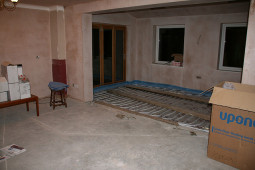 Underfloor heating systems are innovative heating systems that allow you to enjoy the luxury of having warm floors even during the freezing cold winter mornings. Underfloor heating is a convenient system because it can be installed beneath all types of floors—whether stone floors, wooden floors or carpeted surfaces. It is a more efficient alternative rather than when using radiators.
Underfloor heating systems are innovative heating systems that allow you to enjoy the luxury of having warm floors even during the freezing cold winter mornings. Underfloor heating is a convenient system because it can be installed beneath all types of floors—whether stone floors, wooden floors or carpeted surfaces. It is a more efficient alternative rather than when using radiators.
An effective underfloor heating system increases the value of your home and can be a major selling point once you decide to sell your home.
The use of underfloor heating system is gaining popularity and has become the top option among builders because it allows for total control of temperature room-by-room because it can generate more radiant heat. Moreover, underfloor heating system reduces airborne allergens, moisture levels and drafts.
Types of Underfloor Heating System
Radiant identifies two types of floor underfloor heating system: the dry system, also known as the electric underfloor heating and the wet system, better known as water, pump-driven heating.
- Electric underfloor heating. With the electric underfloor heating system, a series of electrical wires are installed within or beneath your flooring. Heating sheets or cables are then fitted on the top layer of the screed and floor insulation, to ensure that the surfaces are completely flat and the heat will travel upwards.
- Water-based underfloor heating. Underfloor heating systems that are water-based require a series of underfloor heating pipes that are connected to a boiler in order to distribute the warm water throughout the house which will in turn, heat the floors. Water-based underfloor heating systemsare ideal when installed during construction of new floors to warrant adequate space for insulation and the pipework.
Advantages Of Water-Based Underfloor Heating Systems
Typically, water-based underfloor heating systems are more expensive compared to the electric underfloor heating system. Furthermore, underfloor heating systems must be installed by a specialist, especially if you are installing a heating system for the entire property.
Although wet underfloor systems are usually associated with new builds, you can have your floors retro-fitted with a minimal rise in the floor height, to accommodate the underfloor water pipes and the insulation. Water-based systems are much easier to run compared with the other underfloor heating system.
Consequently, water underfloor heating systems are inexpensive and more energy efficient in the long run, and at the same time, provides for better distribution of heat on the floors.
Wet system is becoming a popular option, especially for those who want their homes to run on renewable heat sources, because it allows for the low flow of temperature. Hence, it can be a perfect complement to the ground, solar or air energy sources.
Choosing The Best Underfloor Heating Pipes
High quality underfloor heating pipes are essential for a good underfloor water-based heating system. For the wet systems, there are multi-layer pipes developed which are known to be exponentially better than copper pipes used in the earlier days. These multi-layer pipes ensure smoother heating system because of lesser water resistance.
There are currently three types of underfloor heating pipes popularly used these days.
- Cross-Linked Polyethylene with oxygen barrier. Also known as PEX, this pipe comes with an oxygen barrier. It is also easy to install because it is quite pliable and flexible. However, it requires proper fixing with the use of clips, rails or fasteners as it has the tendency to spring back to its original coiled shape. PEX underfloor heating pipes are corrosion-resistant since the oxygen barrier prevents the build-up of corrosion, usually formed when oxygen reacts with the metal parts of the boiler and pumps. It can also withstand simultaneous high pressures and temperatures.
- Multilayer pipe with aluminum layer. The aluminum layer of these pipes also serves as oxygen barrier. It is ideal for installation in suspended floor systems because the aluminum layer allows for the pipe to retain its position once bent, unlike ordinary PEX that springs back to coiled position. These types of underfloor heating pipes are however more expensive than PEX.Polybutylene with oxygen barrier. PB underfloor heating pipes are both durable and flexible. These pipes can withstand high pressures and temperatures, however, just like PEXs, these pipes need fixing as they also return to the original coiled state. One advantage of these types of pipes is that they come in long rolls, therefore burying of any joints underneath the floors is eliminated.
It is essential to have a detailed plan of your water-based underfloor heating system even before the construction commences in order to achieve the optimum benefits of your system. Moreover, finished floor levels must also be taken into consideration to ensure that all installations are at the proper level. High-quality underfloor heating pipes are also essential so that your underfloor heating system will run smoothly and could last much longer.
Featured images:
- License: Creative Commons image source
Elizabeth Harper love to write about home improvement. She gives brilliant tips on basic home cleaning , decors and maintenance.
